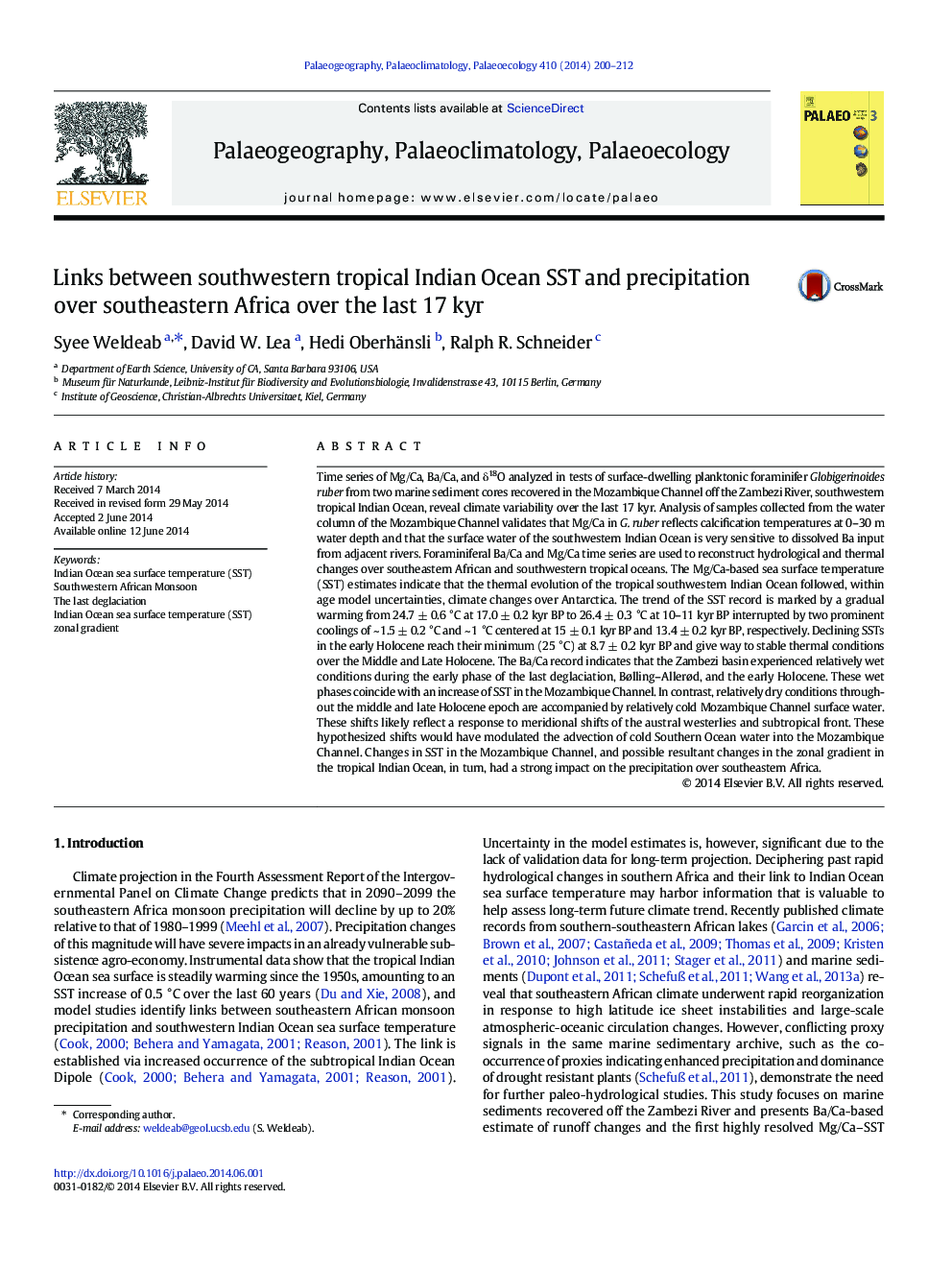| کد مقاله | کد نشریه | سال انتشار | مقاله انگلیسی | نسخه تمام متن |
|---|---|---|---|---|
| 4466120 | 1622180 | 2014 | 13 صفحه PDF | دانلود رایگان |

• SW Indian Ocean and southeastern Africa climate over the last 17 kyr
• SW Indian deglacial SST trend followed the pace of Antarctic climate.
• Thermal link was likely established via shift of the austral Westerlies.
• Wet phases relate to elevated SW Indian Ocean SSTs and a weak zonal SST gradient.
• Deglacial Antarctic climate had a strong control on southeastern Africa climate.
Time series of Mg/Ca, Ba/Ca, and δ18O analyzed in tests of surface-dwelling planktonic foraminifer Globigerinoides ruber from two marine sediment cores recovered in the Mozambique Channel off the Zambezi River, southwestern tropical Indian Ocean, reveal climate variability over the last 17 kyr. Analysis of samples collected from the water column of the Mozambique Channel validates that Mg/Ca in G. ruber reflects calcification temperatures at 0–30 m water depth and that the surface water of the southwestern Indian Ocean is very sensitive to dissolved Ba input from adjacent rivers. Foraminiferal Ba/Ca and Mg/Ca time series are used to reconstruct hydrological and thermal changes over southeastern African and southwestern tropical oceans. The Mg/Ca-based sea surface temperature (SST) estimates indicate that the thermal evolution of the tropical southwestern Indian Ocean followed, within age model uncertainties, climate changes over Antarctica. The trend of the SST record is marked by a gradual warming from 24.7 ± 0.6 °C at 17.0 ± 0.2 kyr BP to 26.4 ± 0.3 °C at 10–11 kyr BP interrupted by two prominent coolings of ~ 1.5 ± 0.2 °C and ~ 1 °C centered at 15 ± 0.1 kyr BP and 13.4 ± 0.2 kyr BP, respectively. Declining SSTs in the early Holocene reach their minimum (25 °C) at 8.7 ± 0.2 kyr BP and give way to stable thermal conditions over the Middle and Late Holocene. The Ba/Ca record indicates that the Zambezi basin experienced relatively wet conditions during the early phase of the last deglaciation, Bølling–Allerød, and the early Holocene. These wet phases coincide with an increase of SST in the Mozambique Channel. In contrast, relatively dry conditions throughout the middle and late Holocene epoch are accompanied by relatively cold Mozambique Channel surface water. These shifts likely reflect a response to meridional shifts of the austral westerlies and subtropical front. These hypothesized shifts would have modulated the advection of cold Southern Ocean water into the Mozambique Channel. Changes in SST in the Mozambique Channel, and possible resultant changes in the zonal gradient in the tropical Indian Ocean, in turn, had a strong impact on the precipitation over southeastern Africa.
Journal: Palaeogeography, Palaeoclimatology, Palaeoecology - Volume 410, 15 September 2014, Pages 200–212